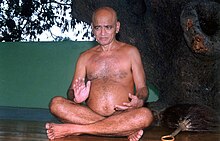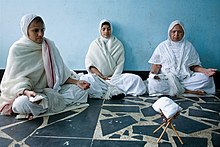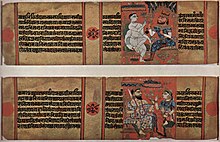Jain monasticism

| Part of a series on |
| Jainism |
|---|
 |
Jain monasticism refers to the order of monks and nuns in the Jain community. The term nirgrantha ("bondless") was used for Jain monks in the past. The monastic practices of two major sects (Digambara and Śvētāmbara) vary greatly, but the major principles of both are identical.
Terminology
Digambaras use the word muṇi for male monastics and aryika for female monastics. Digambara monks are also called nirgrantha (without bonds).[1] Buddhist texts refer to Mahavira, the last Tirthankara, as Nigaṇṭha Jñātaputta. Nigaṇṭha means "without knot, tie, or string"; Jñātaputta (son of Natas) refers to his clan of origin, Jñāta or Naya (Prakrit).[2] Śvētāmbaras use the word sadhvis for female monastics.[3]
History

Historians believe that a united Jain sangha (community) existed before 367 BCE, about 160 years after the moksha (liberation) of Mahavira. The community then gradually divided into two denominations: the Digambara and the Śvētāmbara.[4]
Acharya Kundakunda is the most revered acharya (preceptor) of the Duḥṣamā period of the present avasarpiṇī (descending) era.[5]

Five mahāvratas (Great Vows), from Mahavira's teachings, are followed by all Jain ascetics. Although Jain householders are also required to observe them, ascetics are bound more strictly.[6]
Digambara monks
Digambara monks follow 28 vratas (vows): five mahāvratas (Great Vows); five samitis (regulations); the five-fold control of the senses (pañcendriya nirodha); six Şadāvaśyakas (essential duties), and seven niyamas (restrictions).[7]
| Category | Vow | Meaning |
|---|---|---|
| Mahavratas (Great Vows)[8][9] |
1. Ahimsa | To injure no living being by action or thought |
| 2. Truth | To speak only the truth and good words | |
| 3. Asteya | To take nothing unless it is given | |
| 4. Brahmacharya | Celibacy in action, word and thought | |
| 5. Aparigraha | Renunciation of worldly things | |
| Samiti (regulation of activities)[10][11] |
6. Irya | To walk carefully, after viewing the land four cubits (2 yards) ahead |
| 7. Bhasha | Not to criticise anyone or speak evil words | |
| 8. Eshna | To accept food from a sravaka (householder) if it is free of 46 faults | |
| 9. Adan-nishep | Carefulness in handling whatever the ascetic possesses | |
| 10. Pratishṭapan | To dispose of body waste at a place free of living beings | |
| Panchindrinirodh | 11–15. Control of the senses | Shedding attachment and aversion to objects based sparśana (touch), rasana (taste), ghrāṇa (smell), cakśu (sight), and śrotra (hearing)[12] |
| Essential duties[13][14] | 16. Sāmāyika | Meditate for equanimity towards every living being |
| 17. Stuti | Worship of the tirthankaras | |
| 18. Vandan | To pay obeisances to siddhas, arihantas and acharyas | |
| 19. Pratikramana | Repentance, to drive oneself away from past karma (good or evil) | |
| 20. Pratikhayan | Renunciation | |
| 21. Kayotsarga | Giving up attachment to the body, meditating on the soul | |
| Niyama (rules)[15] |
22. Adantdhavan | Not to use tooth powder to clean teeth |
| 23. Bhushayan | Sleep on hard ground | |
| 24. Asnāna | Not to take bath.[12] | |
| 25. Stithi-bhojan | Eat standing up | |
| 26. Ekabhukti | To take food once in a day[16] | |
| 27. Keśa-lonch | To pluck hair on the head and face by hand[12] | |
| 28. Nudity | To renounce clothing[12] |
Initiation
A Śvētāmbara initiation involves a procession in which the initiate symbolically disposes of his material wealth and makes donations. This is followed (or preceded) by another ritual in which the initiate receives an ogho (a small broom made of wool) from their mentor as a symbol of welcome into the monastic order.[17] The initiate then puts on monastic clothing and pluck out hairs by hand. Further rituals formally initiate them into the monastic order. The Śvētāmbara Terapanth sect requests written permission from a person's parents before initiating them into the ascetic order.[18]
Rules of conduct

The earliest known texts often ask for ascetics to be in complete solitude, identifying the isolation of soul and non-soul. However, soon after Mahavira's death ascetics organized themselves into groups.[3] A few examples of ascetics living in complete solitude are found in the Digambara sect.[19]
Jain ascetics are detached from social and worldly activities; all activities are aimed at self-purification for self-realization. They follow established guidelines for daily worship and austerity.[17]
The monk's daily routine is broadly structured by three ideological formulae: the five great vows (mahavrata), the eight matrices of doctrine (pravacana-matrka), and the six obligatory actions (avasyaka). The first two are restrictions, and the third is positively framed in what the monk is encouraged to do daily.[20]
Ascetics do not have a home or possessions.[3] They choose austerity, avoid services such as telephones and electricity.[21] Monks engage in activities such as meditation, seeking knowledge and acquiring self-discipline.[22]
The Yati of the Śvētāmbara sect and the Bhattaraka of the Digambara Terapanth do not wander; they usually live in temples and perform daily rituals.[3]
The monks rise before dawn, most around 5:00 a.m. but some as early as 2:00 a.m. In observance of utsarg-samiti, defecation takes place in the open in order to prevent harm to living creatures; urination is into a shallow pan, which is emptied onto a dry patch of ground.[20]
Ranks

Monks and nuns from the Digambara traditions are assigned to ranks:[23]
| Rank | Monk | Nun |
|---|---|---|
| 1 | Acharya | Ganini Aryika Pramukha |
| 2 | Elachary | Ganini Aryika |
| 3 | Upadhyay | Aryika |
| 4 | Muni | Mataji |
| 5 | Kshullak | Kshullika |
| 6 | Brahmachari | Brahmacharini |
| 7 | Śrāvaka | Śrāvika |
In the Digambara tradition, an ascetic rises from kshullak (one who uses two pieces of cloth) through Ailak (uses one piece of cloth) to muni (or sadhu). Over time a number of designations were mentioned in shastras, such as gani, pannyas and pravartak. The Śvētāmbara Terapanth sect has a new rank of junior monks, samana.[24]
Attire and possessions

Observing complete abstinence, male Digambara monks wear no clothing.[25] Aryikas wear plain, seamless white sarees.[4] All Digambara monks and nuns traditionally carry only three things: a mor-pichhi (peacock-feather whisk), a kamandalu (water pot) and shastras (scriptures).[26]
Śvētāmbara monastics wear white, seamless clothing.[4]
Chaturmas
Chaturmas is the four-month monsoon period during which ascetics stay in one place to reduce the risk of accidentally killing insects and other small forms of life which thrive during the rains. This period is suitable for sravakas to renew their faith by listening to teachings of the dharma, meditation and vartas (acts of self-control).[27]
During Chaturmas, the chief sadhu of each group gives a daily pravacana or vyakhyana (sermon) attended mostly by women and retired men but on special days by most of the lay congregation. During their eight months of travel, the sadhus give sermons whenever requested (most often when they arrive in a new village or town in their travels).[28]
Mahavira's asceticism
The Kalpa Sūtra describes Mahavira's asceticism in detail; from it, most of the ascetic practices (including the restraints and regulations) are derived:[29]
The Venerable Ascetic Mahavira for a year and a month wore clothes; after that time he walked about naked, and accepted the alms in the hollow of his hand. For more than twelve years the Venerable Ascetic Mahavira neglected his body and abandoned the care of it; he with equanimity bore, underwent, and suffered all pleasant or unpleasant occurrences arising from divine powers, men, or animals.
— Kalpa Sūtra 117
Henceforth the Venerable Ascetic Mahavira was houseless, circumspect in his walking, circumspect in his speaking, circumspect in his begging, circumspect in his accepting (anything), in the carrying of his outfit and drinking vessel; circumspect in evacuating excrement, urine, saliva, mucus, and uncleanliness of the body; circumspect in his thoughts, circumspect in his words, circumspect in his acts; guarding his thoughts, guarding his words, guarding his acts, guarding his senses, guarding his chastity; without wrath, without pride, without deceit, without greed; calm, tranquil, composed, liberated, free from temptations, without egoism, without property; he had cut off all earthly ties, and was not stained by any worldliness: as water does not adhere to a copper vessel, or collyrium to mother of pearl (so sins found no place in him); his course was unobstructed like that of Life; like the firmament he wanted no support; like the wind he knew no obstacles; his heart was pure like the water (of rivers or tanks) in autumn; nothing could soil him like the leaf of a lotus; his senses were well protected like those of a tortoise; he was single and alone like the horn of a rhinoceros; he was free like a bird; he was always waking like the fabulous bird Bharundal, valorous like an elephant, strong like a bull, difficult to attack like a lion, steady and firm like Mount Mandara, deep like the ocean, mild like the moon, refulgent like the sun, pure like excellent gold'; like the earth he patiently bore everything; like a well-kindled fire he shone in his splendour.
— Kalpa Sūtra 118
See also
Notes
- ^ B.K. Jain 2013, p. 62.
- ^ Zimmer 1953, p. 223.
- ^ a b c d Dundas 2002, p. 152.
- ^ a b c Dundas 2002, p. 45.
- ^ Jain 2011, p. vi.
- ^ Pravin Shah, Five Great Vows (Maha-vratas) of Jainism Jainism Literature Center, Harvard University Archives (2009)
- ^ Jain 2013, p. 196-197.
- ^ Jain 2011, p. 93–100.
- ^ Jain 1926, p. 26.
- ^ Jain 2012, p. 144-145.
- ^ Jain 1926, p. 32-38.
- ^ a b c d Jain 2013, p. 196.
- ^ Jain 2012, p. 143.
- ^ Jain 2013, p. 190-191.
- ^ Jain 1926, p. 46-47.
- ^ Jain 2013, p. 197.
- ^ a b "Welcome to Jainworld - Jain Monks nuns, Sadhu, Shraman, Muni, Sadhvi, Shramani, Ary�, Pranatip�taviraman Mahavrat, Mrishavadaviraman Mah�vrat, Adattad�naviraman Mahavrat , Maithunaviraman Mahavrat, Parigrahaviraman Mahavrat", Jainworld.com
- ^ Dundas 2002, p. 155.
- ^ Dundas 2002, p. 153.
- ^ a b Cort 2001, p. 101.
- ^ Singhvi, Sushila, Jainism at a glance, archived from the original on 27 February 2012
{{citation}}: Unknown parameter|deadurl=ignored (|url-status=suggested) (help) - ^ Singh 2007, p. 29.
- ^ Valley, Anne (2002). Guardians of the Transcedent: An Ethnography of a Jain Ascetic Community. University of Toronto Press.
- ^ Singh 2007, p. 119.
- ^ Zimmer 1953, p. 210.
- ^ Singh 2008, p. 316.
- ^ Mehta, Makrand (1991), Indian merchants and entrepreneurs in historical perspective: with special reference to shroffs of Gujarat, 17th to 19th centuries, Academic Foundation, p. 98, ISBN 81-7188-017-7
- ^ Cort 2001, p. 104.
- ^ Jacobi, Hermann (1884). (ed.) F. Max Müller (ed.). The Kalpa Sūtra. Sacred Books of the East vol.22, Part 1. Oxford: The Clarendon Press. ISBN 0-7007-1538-X.
{{cite book}}:|editor=has generic name (help) Note: ISBN refers to the UK:Routledge (2001) reprint. URL is the scan version of the original 1884 reprint
References
- Jain, Vijay K. (2013), Ācārya Nemichandra's Dravyasaṃgraha, Vikalp Printers, ISBN 9788190363952,
 This article incorporates text from this source, which is in the public domain.
This article incorporates text from this source, which is in the public domain. - Snehadeep (2013), Secrets Of Jainism, Multy Graphics
- Jain, Babu Kamtaprasad (2013), Digambaratva aur Digambar muni, Bharatiya Jnanpith, ISBN 81-263-5122-5
- Jain, Vijay K. (2012), Acharya Amritchandra's Purushartha Siddhyupaya, Vikalp Printers, ISBN 81-903639-4-8,
 This article incorporates text from this source, which is in the public domain.
This article incorporates text from this source, which is in the public domain. - Jain, Vijay K. (2011), Acharya Umasvami's Tattvārthsūtra (1st ed.), Uttarakhand: Vikalp Printers, ISBN 978-81-903639-2-1,
 This article incorporates text from this source, which is in the public domain.
This article incorporates text from this source, which is in the public domain. - Singh, Upinder (2008), A History Of Ancient And Early Medieval India: From The Stone Age To The 12th Century, Pearson Education India, ISBN 978-81-317-1120-0
- Singh, N. K.; Mishra, A. P. (2007), Encyclopaedia of Oriental Philosophy: Jainism, vol. 7, Global Vision Publishing House, ISBN 81-8220-113-6
- Cort, John E. (2001), Jains in the World : Religious Values and Ideology in India, Oxford University Press, ISBN 0-19-513234-3
- Dundas, Paul (2002) [1992], The Jains (Second ed.), Routledge, ISBN 0-415-26605-X
- Jaini, Padmanabh S. (1991), Gender and Salvation: Jaina Debates on the Spiritual Liberation of Women, University of California Press, ISBN 0-520-06820-3
- Zimmer, Heinrich (1953) [April 1952], Campbell, Joseph (ed.), Philosophies Of India, London, E.C. 4: Routledge & Kegan Paul Ltd, ISBN 978-81-208-0739-6,
 This article incorporates text from this source, which is in the public domain.
This article incorporates text from this source, which is in the public domain.{{citation}}: Unknown parameter|editorlink=ignored (|editor-link=suggested) (help)CS1 maint: location (link) - Jain, Champat Rai (1926), Sannyasa Dharma
External links
- List of All Digamber Jain Monks With detailed description
